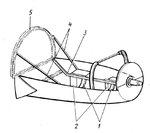FLYBOYJ
"THE GREAT GAZOO"
It depends on the hardness and thickness of the armor you're trying to pierce. The Harder the plate the more brittle it becomes when you put a direct load to it in an unsupported area. If the penetrating material has a correlating harness to the the surface trying to be penetrated as well as the right shape at the tip, then the right amount of force behind it will do the rest. I could take a cone or sharpened shaped steel object with a Rockwell harness of say C40 and with enough force penetrate a plate with a hardness of say C60 if the thickness of the plate cannot sustain the load behind the object. The object doing the penetrating may distort, crack or break as you put it, but it will penetrate the plate if the thickness AND brittleness of the plate can't support the dynamic load of the object being forced (or fired) at it.It's not has the bearing of anything, it's just a question of the utmost performance in armor piercing matters. So you'll never pierce a safe with a flashball or with a wood-drill. With weight and velocity, of coarse you can just brake it, by craking it. It's not the same thing.
VG


